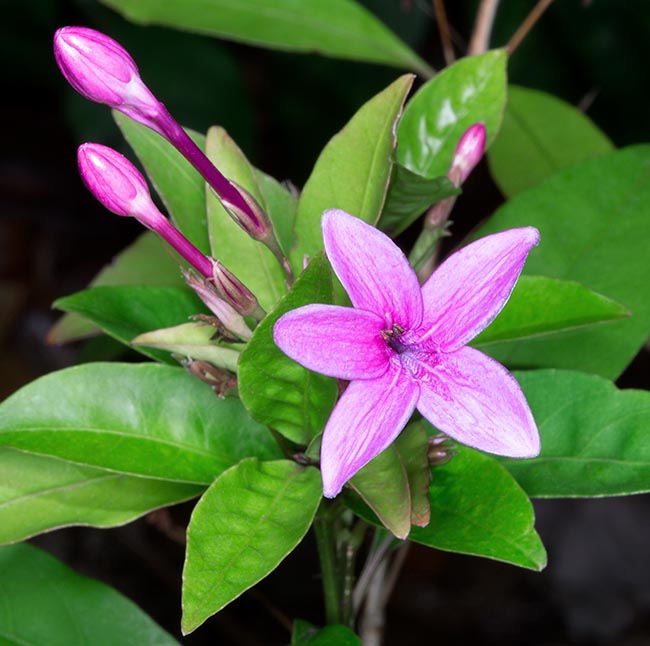Family : Acanthaceae

Text © Pietro Puccio

English translation by Mario Beltramini

Pseuderanthemum laxiflorum is native to Fiji Islands and New Hebrides where grows in the pluvial forests at low and medium altitudes. Fast growth and easy cultivation in the tropical gardens and warm temperate climates © Giuseppe Mazza
The name of the genus is the combination of the Greek prefix “ψευδο-“ = false and of the genus Eranthemum ; the specific name is the combination of the Latin adjective “laxus, a, um” = weary, little compact, and of the substantive “flos, -oris” = flower.
Common names: amethyst star, shooting star, star flower (English); flor estrella (Spanish).
The Pseuderanthemum laxiflorum (A. Gray) F.T. Hubb. ex L.H. Bailey (1916) is a ramified evergreen shrub, 0,8-1,6 m tall, with leaves, on short petiole, opposite, simple, oblong-lanceolate with entire margin, 4-12 cm long and 2-4 cm broad, of glossy intense green colour; varieties with mottled leaves have been selected. Cymose inflorescences at the axil of the upper leaves carrying few flowers of 2,5-3 cm of diameter of purple pink colour. Calyx deeply divided in 5 long and narrow lobes, hypocraterimorphous corolla (with spread lobes perpendicular to a long thin tube) with cylindrical tube about 2,5 cm long, 5 ovate lobes, the three lower ones slightly broader than the two upper ones, 2 prominent stamina, style longer than the stamina and bilobed stigma. The fruit is a capsule containing 4 lenticular seeds. It reproduces by seed, in draining organic loam maintained humid at the temperature of 24-26 °C, and by cutting in summer.
Fast growing species and easy to cultivate, with abundant long lasting blooming, from spring to autumn, utilizable as isolated specimen, in group or for borders, even mixed, in the tropical, subtropical and marginally warm temperate climate zones, where temperatures just under the 0 °C are short lasting exceptions, with possible loss of the aerial part, but regrowth in spring if well mulched. It requires full sun or partial shade and well drained soils with frequent waterings during the vegetative period, so to maintain the substratum almost constantly humid, but without stagnations, more spaced in winter allowing the upper layer of the loam to dry up before watering again. It needs frequent prunings in order to keep the posture compact and to stimulate the blooming. For a lush bloom are useful the fertilizations from spring to autumn, on a monthly basis, utilizing a balanced product, with microelements. Cultivable also in pot, utilizing an organic loam with addition of sand or of agri perlite per a 30%, for the decoration of open spaces, where the climate allows so, or luminous inner spaces.
Synonyms: Eranthemum laxiflorum A.Gray (1862).
